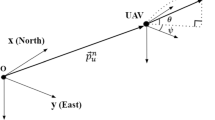Abstract
In this paper, we propose a novel curved path following scheme for multiple fixed-wing unmanned aerial vehicles (UAVs) that can achieve coordinated curved path following and handle collision avoidance simultaneously. The proposed solution is a hybrid system that combines a path following strategy and a collision avoidance method to ensure collision-free maneuvering of a group of UAVs cooperative flight. A strategy based on a virtual structure and a kinematic model is proposed to derive the cooperative curved path following. Meanwhile, a possible collision will occur when multi-UAVs flight in the form of dense formations, or there are path intersections when the formation is changed. However, all fixed-wing vehicles need to maintain a minimum airspeed and cannot stop before the collision. Therefore, there is a need for a fast and efficient method that can be implemented online, taking into account the physical limitations of the vehicle (minimum speed, turning rate, etc.) to avoid possible collision. We employ a modified vector field histogram (VFH) method to provide real-time collision avoidance, and evasive maneuvers work only if the distance is within the conflict zone. In order to verify the proposed control scheme, dense formation flight tests of small fixed-wing UAVs were implemented.
Similar content being viewed by others
Explore related subjects
Discover the latest articles and news from researchers in related subjects, suggested using machine learning.References
Wang, X., Yadav, V., Balakrishnan, S.N.: Cooperative uav formation flying with obstacle/collision avoidance. IEEE Trans. Control Syst. Technol. 15(4), 672–679 (2007)
Patil, S., van, J., Alterovitz, R.: Estimating probability of collision for safe planning under gaussian motion and sensing uncertainty. In: Proceedings of the IEEE International Conference on Robotics and Automation, pp 3238–3244 (2012)
Richards, A., How, J.: Decentralized model predictive control of cooperating uavs. In: IEEE Conference on Decision and Control, pp 3238–3244 (2005)
Sathyaraj, B.M., Jain, L.C., Finn, A., S. Drake.: Multiple uavs path planning algorithms: a comparative study. Fuzzy Optim. Decis. Making 7(3), 257–267 (2008)
Koenig, S., Likhachev, M.: Fast replanning for navigation in unknown terrain. IEEE Trans. Robot. 21(3), 354–363 (2005)
Abichandani, P., Ford, G., Benson, H.Y., Kam, M.: Mathematical programming for multi-vehicle motion planning problems. In: Proceedings of the IEEE International Conference on Robotics and Automation, pp 3315–3322 (2012)
Besada-Portas, E., Torre, L., Cruz, J.M., Andres-Toro, B.: Evolutionary trajectory planner for multiple uavs in realistic scenarios. IEEE Trans. Robot. 26(4), 619–634 (2010)
Alejo, D., Cobano, J.A., Heredia, G., Ollero, A.: Collision-free 4d trajectory planning in unmanned aerial vehicles for assembly and structure construction. J. Intell. Robot. Syst. 73(1), 783–795 (2014)
Ge, S.S., Cui, Y.J.: New potential functions for mobile robot path planning. IEEE Trans. Robot. Autom. 16(5), 615–620 (2000)
Matveev, A.S., Teimoori, H., Savkin, A.V.: A method for guidance and control of an autonomous vehicle in problems of border patrolling and obstacle avoidance. Automatica 47(3), 505–514 (2011)
Matveev, A.S., Hoy, M., Savkin, A.V.: The problem of boundary following by a unicycle-like robot with rigidly mounted sensors. Robot. Auton. Syst. 61(3), 312–327 (2013)
Huang, L.: Wall-following control of an infrared sensors guided wheeled mobile robot. Int. J. Intell. Sys. 7(1), 106–117 (2009)
Lan, Y., Yan, G., Lin, Z.: Synthesis of distributed control of coordinated path following based on hybrid approach. IEEE Trans. Autom. Control 56(5), 1170–1175 (2011)
Beard, R.W., Ferrin, J., Humpherys, J.: Fixed wing uav path following in wind with input constraints. IEEE Trans. Control Syst. Technol. 22(6), 2103–2117 (2014)
Fukushima, H., Kon, K., Matsuno, F.: Distributed model predictive control for multi-vehicle formation with collision avoidance constraints. In: Proceedings of the 44th IEEE Conference on Decision and Control, pp 5480–5485 (2005)
Nelson, D.R., Barber, D.B., McLain, T.W., Beard, R.W.: Vector field path following for miniature air vehicles. IEEE Trans. Robot. 23(3), 519–529 (2007)
Aguiar, A., Hespanha, J., Kokotovic, P.: Performance limitations in reference tracking and path following for nonlinear systems. Automatica 44(3), 598–610 (2008)
Jiang, Z.P., Nijmeijer, H.: Tracking control of mobile robots : a case study in backstepping. Automatica 33(1), 1393–1399 (1997)
Borenstein, J., Koren, Y.: The vector field histogram-fast obstacle avoidance for mobile robots. IEEE Trans. Robotics Automation 7(3), 278–288 (1991)
Zhao, S., Wang, X., Zhang, D., Shen, L.: Curved path following control for fixed-wing unmanned aerial vehicles with control constraint. J. Intell. Robot. Syst. 89(1-2), 107–119 (2018)
Zhao, S., Wang, X., Zhang, D., Shen, L.: Model-free fuzzy adaptive control of the heading angle of fixed-wing unmanned aerial vehicles. Journal of Aerospace Engineering 30(4) (2017)
Author information
Authors and Affiliations
Corresponding author
Additional information
Publisher’s Note
Springer Nature remains neutral with regard to jurisdictional claims in published maps and institutional affiliations.
This work is supported by National Natural Science Foundation (NNSF) of China under Grant 61973309.
Rights and permissions
About this article
Cite this article
Zhao, S., Wang, X., Chen, H. et al. Cooperative Path Following Control of Fixed-wing Unmanned Aerial Vehicles with Collision Avoidance. J Intell Robot Syst 100, 1569–1581 (2020). https://doi.org/10.1007/s10846-020-01210-3
Received:
Accepted:
Published:
Issue Date:
DOI: https://doi.org/10.1007/s10846-020-01210-3




